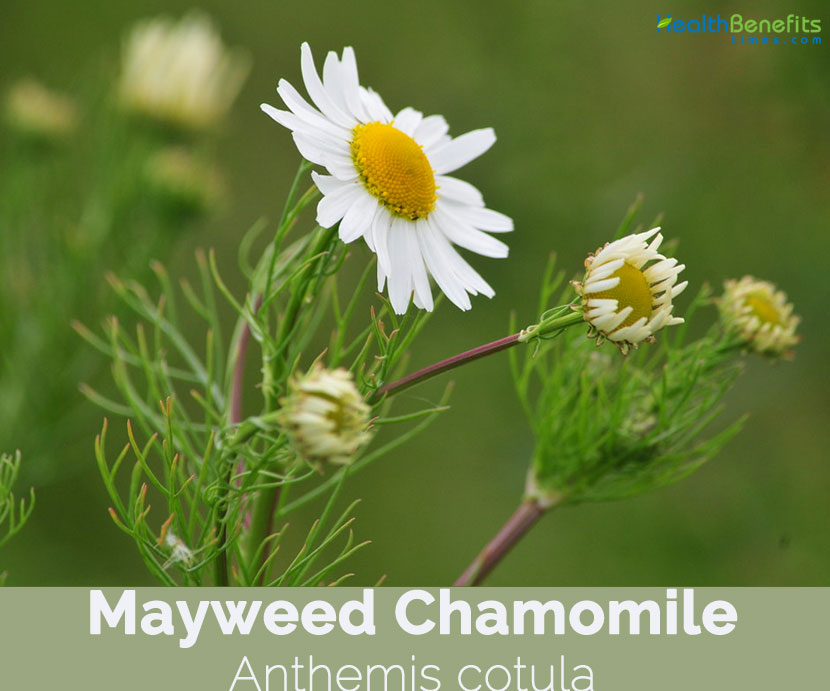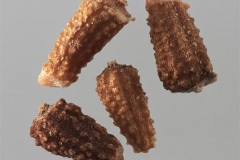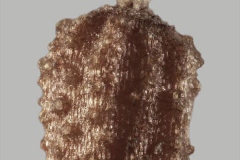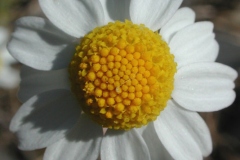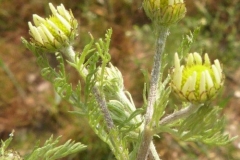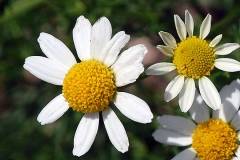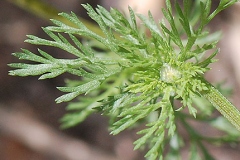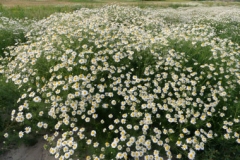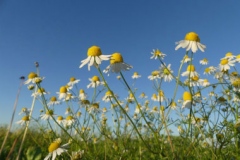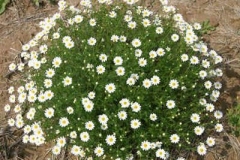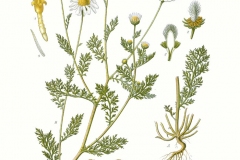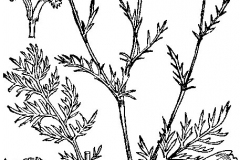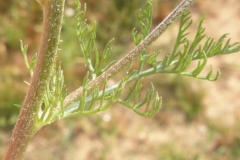| Mayweed Chamomile Quick Facts | |
|---|---|
| Name: | Mayweed Chamomile |
| Scientific Name: | Anthemis cotula |
| Origin | Europe, Turkey, the Eastern Mediterranean, the Caucasus |
| Colors | Straw yellow to brown |
| Shapes | Wedge-shaped achenes tapering to the base approximately 1.0 - 2.3 mm long and 0.8 - 1.0 mm wide |
| Taste | Bitter |
| Health benefits | Beneficial for rheumatism, epilepsy, asthma, colds, fevers, intestinal ailments, insect stings and dysentery |
| Name | Mayweed Chamomile |
|---|---|
| Scientific Name | Anthemis cotula |
| Native | Europe, Turkey, the Eastern Mediterranean, the Caucasus, Iran, Iraq, North Africa, Ethiopia, South America, Australia and New Zealand |
| Common Names | Chamomile, dog fennel, foetid chamomile, mayweed, mayweed chamomile, stinking chamomile, stinking mayweed, stinkweed, wild chamomile, mather, dog-finkle, dog-daisy, pig-sty-daisy, chigger-weed, Johnnyweed, maroute, Maruta cotula, Cotula Maruta foetida, Manzanilla loca, wild chamomile, Camomille puante, maithes, maithen, mathor, camomille des chiens, camomille puante, stinkende Hundskamille, camomila-de-cachorro, macéla-fétida, manzanilla hedionda, Dillweed, Dog’s Camomile, Wild Chamomile, Hog’s Fennel, Dog-finkle, Morgan, Maise, Chigger-weed, Balders |
| Name in Other Languages | Afrikaans: Stink-kamile, kamille Albanian: Maraq, syviç, mayweed Amharic: Mayweed Arabic: Aqhawan khamn (أقحوان خمن), sakab ‘abyad (سَكَب أَبْيَض); fus alkilab (فُصّ الكِلاب), qahwan (قَحْوان) Aragonese: Ruda Armenian: Ant’em garshahot (անթեմ գարշահոտ), Ant’em shnayin (Անթեմ շնային), armenian Asturian: Manzanilla montés Azerbaijan: Pisiǰ sıġır ҝözü (Писиј сығыр ҝөзү), mayweed Bengali: Mayweed Bulgarian: Plosko podrumiche (Плоско подрумиче), kucheshkata laĭka (кучешката лайка), rada (рада) Burmese: Kyaway (ကြွေ) Catalan: Camamilla pudent, camamilla pudenta, guirlanda, segura Chinese : Chou gan ju, Chou chun huang ju (臭春黄菊), Wǔ yuè zá cǎo (五月杂草) Corsican: Cotula Croatian: Marundela, Ravan, Smilj, Smrdljivi jarmen, Smrdući jarmen, prstenak Czech: Rmen smrdutý, mayweed Danish : Stinkende gåseurt, Kamille Dutch : Stinkende kamille, Mayweed English: Dog’s fennel, Mayweed, Mayweed chamomile, Stinking chamomile, Stinking mayweed, chamomile, Foetid chamomile, Mayweed dogfennel, Stinkweed, Wild chamomile, wild chamomile, dog chamomile Esperanto: Mayweed Estonian: Haisev karikakar, mairohi Euskera: Bicheleta Filipino: May utang na loob Finnish: Haisusauramo, saunio French: Anthémis puant, Anthémis puante, Camomille bâtarde, Camomille des chiens, Camomille puante, Oeil de vache, Camomille maroute, Maroute, Anthémis fétide, Camomille fétide, maroute puante, anthémis cotule, anthémis des chiens, asclépiade Galician: Finéal madra, herba do hecho Georgian: Kamania (კამანია), shesadzlebelia (შესაძლებელია) German : Hundskamille, Stinkende Hundskamille, Stink-Hundskamille Greek: Mayweed-ˈmāwēd Gujarati: Māyavēḍa (માયવેડ) Hausa: Mayweed Hebrew: Kachvan mekuppach, קחוון מקפח; קַחְוָן מְקֻפָּח High Aragonese: Ruda Hindi: Mayweed Hungarian: Nehézszagú pipitér Icelandic: Hnotgæsajurt, Mayweed Indonesian: Semoga Irish: Finéal madra, Mayweed Italian: Camomilla fetida, Camomilla mezzana, camomilla cotula, cotula fetida, tribolo Japanese: Kamitsuremodoki (カミツレモドキ), Kamome (かもめ) Javanese: Mayang Kannada: Mēvīḍ (ಮೇವೀಡ್) Kazakh: Mayweed Korean: Gae kkot a jae bi (개꽃아재비), macho (마초) Kurdish: Mayweed Lao: Mayweed Latvian: Suņu ilzīte, maijvabole Lithuanian: Šuninis bobramunis, gegužė Macedonian: Majmun (мајмун) Majorcan: Camamilla pudenta, camamirla pudenta Malagasy: Mayweed Malayalam: Meyvīḍ (മെയ്വീഡ്) Maltese: Mayweed Marathi: Meved (मेवेड) Moldovian: Romanitse kyneluy (Романицэ кынелуй) Mongolian: Mayweed-ˈmāˌwēd Nepali: Mayweed-ˈmāˌwēd Netherlands: Stinkende kamille Norwegian: Tappgåseblom, Mayweed Occitan: Amaron, Bolèg pudent, Camomiho pudento, Olet, Olhòl Oriya: Mayweed Pashto: میویډ Persian: بابونه بهاری Polish: Rumian psi, mayweed Portuguese: Macela-fétida, camomila-de-cachorro, cotula bastarda, marcella fétida, margaça, erva-mijona, fedegosa, funcho-de-burro, macela-fedegosa, erva daninha, erva daninha Punjabi: Ma īvēḍa (ਮਈਵੇਡ) Romanian: Romaniță cînelui, romoniţă-puturoasă, romashka nepakhuchaya (ромашка непахучая) Russian: Pupavka sobach’ia (Пупавка собачья ) Serbian: žablja trava (жабља трава), ramenak (раменак), maiveed (маивеед) Sindhi: مايوس ٿي سگھي ٿو Sinhala: Mayweed-ˈmāˌwēd Slovak: Ruman smradľavý Slovenian: Smrdeljika, Smrdljiva pasja kamilica Spanish : Camomilla pudenta, manzanillon, camomila fina, cotula fétida, magarza hedionda, magarza pajosa, magarza pobre, manzanilla de burro, manzanilla fétida, manzanilla hedionda, margarita fedionda, margaza, margazuela, matagata, matagatas, ojo de caballo, manzanillón Sundanese: Mayweed Swedish: Kamomillkulla, surkulla, sommarkyndel, baldersbrå Tajik: Mayweed-ˈmāwēd Tamil: Mēvīṭ (மேவீட்) Telugu: Mēvīḍ (మేవీడ్) Thai: Mayweed-ˈmāwēd Turkish: Hozan çiçeği, mayweed Ukrainian: Roman sobachiy (Роман собачий), mayweed Urdu: میویڈ Uzbek: Mayweed Valencian: Camamilla de monte, camamilla pudenta, camamirla de mont Vietnamese: Rau răm Welsh: Camri`r cŵn, mayweed Zulu: Mayweed |
| Plant Growth Habit | More or less branched, usually sub glabrous, foul-smelling annual, bushy, branched herb |
| Growing Climates | Found in landscape, nurseries, agricultural crops, roadsides, in meadows, in disturbed areas, cultivated fields, pastures, gardens, lawns and railway lines |
| Soil | Most frequently on fertile clay and clay-loam soils. Favorable soil conditions are rather wet, weakly acidic to alkaline with high nitrogen content. It may also occur on medium-textured soils, particularly if sites are poorly drained, but is usually rare or absent on light soils |
| Plant Size | Varies from 12 inches (28 centimeters) to 24 inches (56 centimeters) |
| Root | Fibrous root system along with a taproot |
| Stem | 1-3 feet in height, branched from the base (usually) and green in color. The stems are glabrous or pubescent and gland dotted. It has Strong disagreeable smell when crushed and bitter taste |
| Leaf | Leaf blades are about 0 .75 – 2.5 in. (1.9-6.35 cm) long and 1 in. (2.54 cm) wide. The first leaves are opposite but become alternate as they ascend up the stem |
| Flowering season | July to September |
| Flower | Flower heads are 19 mm in diameter. Each flower head usually has 12 ray flowers. Disk flowers are yellow and numerous |
| Fruit Shape & Size | Wedge-shaped achenes tapering to the base approximately 1.0 – 2.3 mm long and 0.8 – 1.0 mm wide |
| Fruit Color | Straw yellow to brown |
| Propagation | By seed |
| Flavor/Aroma | Noticeable and strong odor |
| Seed | Slightly flattened, ribbed, glandular, and bumpy. They lack pappi |
| Taste | Bitter |
| Plant Parts Used | Flowers, leaves |
Leaves
The leaves of the plant sometimes have very fine and soft hairs on the upper surface, although the plant is mostly hairless. There is no leaf stalk; leaves grow immediately from the stems. The first leaves are opposite but become alternate as they ascend up the stem. The leaves are alternate, thick, finely dissected, and pinnate in shape, with many extremely thin lobes, and can be 1.8-3.5 cm long and 2.5 cm wide. Leaves emit an unpleasant odor when crushed.
Flowers
Each stem is topped by a single flower head which is usually around 1 inch (2.5 cm) in diameter. The flower head is encompassed by between 10 and 18 white ray florets with yellow centers (disk florets), each with a three-toothed shape; the florets tend to curve downwards around the edges and may occasionally have pistils, although these do not produce fruit. Beneath the flower proper, oval bracts of the plant form an involucre, with soft hairs on each; further bracts are bristled and sit at right angles to the flowers. Flowering normally takes place from July to September.
Fruits and seeds
Fertile flowers are followed by wedge-shaped achenes (with no pappus) tapering to the base approximately 1.0 – 2.3 mm long and 0.8 – 1.0 mm wide. They are wrinkled, ribbed with ten ridges, and have small glandular bumps across the surface. They are without any bristly or fluffy pappus and are distributed by the wind shaking the stem and by water as the seeds are light enough to float easily. Seeds are ribbed and covered in small protrusions (tubercules) and often gland-dotted. A single flower head may contain 50-75 seeds. The average plant will produce from 600 to 12,000 seeds but plants with 27,000 seeds have been recorded. Large plant can produce up to 960,000 seeds which remain viable in soil for a number of years. The plant spread widely in earlier times as the small seeds were frequently found as an impurity in grass and clover seed.
Traditional uses and benefits of Mayweed Chamomile
- Mayweed Chamomile is closely related to chamomile, but is far less effective as a medicine.
- It has been used as an antispasmodic and to induce menstruation and was traditionally used to treat supposedly hysterical conditions related to the uterus.
- It is rarely used in contemporary herbal medicine.
- Whole plant is antispasmodic, astringent, diaphoretic, diuretic, emetic, emmenogogue and tonic.
- It is used internally as a tea, which can be made either from the flowers or the whole plant, though the flowers are less unpleasant and so are more commonly used.
- An infusion is used in the treatment of a variety of complaints such as rheumatism, epilepsy, asthma, colds and fevers.
- Applied externally, it is used as a poultice on piles or to draw splinters out of the body, and can also be applied to the bath water.
- The leaves can also be rubbed onto insect stings.
- Mayweed Chamomile has been used as a medicinal herb to cure various intestinal ailments.
- In hysteria it is used in Europe as an antispasmodic and emmenogogue.
- It is used to induce sleep in asthma.
- It is believed to be almost as important as opium in dysentery.
- It has been used as an antispasmodic and to induce menstruation and was traditionally used to treat supposedly hysterical conditions related to the uterus.
- An infusion is used in the treatment of a variety of complaints such as rheumatism, epilepsy, asthma, colds and fevers.
- Applied externally, it is used as a poultice on piles or to draw splinters out of the body, and can also be applied to the bath water.
Culinary Uses
- The herb is used as a flavoring in Peru due to its aromatic property.
- Herb tea is made from the flowers in a similar way to chamomile tea and it has a similar though weaker effect medicinally.
Other Facts
- The growing and the dried plant is said to repel mice and fleas, it can also be used as an insecticide.
- Gold dye is obtained from the whole plant.
- Plants of average size are capable of producing from 550 to 12,000 seeds.
- All parts of the plant produce an unpleasant odor when injured.
- The odor is not very pleasant and so it is not commonly used.
Prevention and Control
Due to the variable regulations around (de)registration of pesticides, your national list of registered pesticides or relevant authority should be consulted to determine which products are legally allowed for use in your country when considering chemical control. Pesticides should always be used in a lawful manner, consistent with the product’s label.
Cultural Control
Cultural control of A. cotula is achieved by methods including improved drainage, crop rotation, using competitive varieties, and delayed spring planting. Improved seed cleaning techniques have lessened the abundance of A. cotula, particularly in cereal grain rotations.
Mechanical Control
As an annual weed, A. cotula is easily controlled by digging, particularly in early growth stages. Mechanical control may be applied pre-plant, pre-emergence, or in-row for effective control. Hand-weeding is also quite effective, but can be extremely laborious with heavy infestations, and the plant may cause irritation.
Chemical Control
Sulfonylurea herbicides effectively control A. cotula. However, biotypes have been identified that are resistant to this group of herbicides. Clopyralid, picloram, and triclopyr provide good control of A. cotula, mainly when applied with growth-regulating herbicides such as dicamba, 2, 4-D, or MCPA. Control is only fair with applications of dicamba, 2, 4-D, or MCPA alone. Control is fair to good with metribuzin and diuron.
Control of A. cotula in forage crops using herbicides was investigated by Smith (1987). Glyphosate and paraquat applied during mid-March after germination of A. cotula and before initiation of growth by forage species provided good weed control with minimal crop damage.
Biological Control
Although certain insects and pathogens are known to attack A. cotula, no biological control programs have been developed.
Integrated Control
Problems caused by A. cotula in crop production are limited to cereal rotations. Crop rotations utilizing varying planting dates and herbicide are effective for control. In pastures and forage production, improving plant competition via inter-seeding or fertilizer application can be effective in control. Eliminating seed introduction via contaminated seed, hay, bedding, or manure is most effective in preventing new or re-infestations of A. cotula.
Precautions
- Whole plant is penetrated by an acrid juice; touching or ingesting the plant can cause allergies in some people.
- Some people are allergic to the plant and this remedy could give them painful blisters.
- This herb is contraindicated for pregnant women or nursing mothers.
- Anthemis cotula is potentially toxic to dogs, cats, horses, and guinea pigs.
- Long term use can lead to bleeding tendencies.
- Foliage may also cause skin irritation.
- Plant can cause dermatitis, vomiting, diarrhea, anorexia, other allergic reactions, and death.
- Whole plant is antispasmodic, astringent, diaphoretic, diuretic, emetic, emmenogogue and tonic.
- Some people are allergic to the plant and this remedy could give them painful blisters.
- A strong decoction can cause sweating and vomiting.
References:
https://www.itis.gov/servlet/SingleRpt/SingleRpt?search_topic=TSN&search_value=36330#null
http://www.hear.org/pier/species/anthemis_cotula.htm
https://pfaf.org/user/Plant.aspx?LatinName=Anthemis+cotula
https://www.cabi.org/isc/datasheet/5672
http://www.floracatalana.net/anthemis-cotula-l-
https://botanical.com/botanical/mgmh/m/maywee26.html
https://plants.usda.gov/core/profile?symbol=ANCO2
https://en.wikipedia.org/wiki/Anthemis_cotula
https://accs.uaa.alaska.edu/wp-content/uploads/Anthemis_cotula_BIO_ANCO2.pdf
https://www.invasiveplantatlas.org/subject.html?sub=5106
http://floraofalabama.org/Plant.aspx?id=515
https://npgsweb.ars-grin.gov/gringlobal/taxonomydetail.aspx?103883
https://en.hortipedia.com/Anthemis_cotula
http://www.theplantlist.org/tpl1.1/record/gcc-131879
https://gd.eppo.int/taxon/ANTCO
https://www.flowersofindia.net/catalog/slides/Stinking%20Chamomile.html


